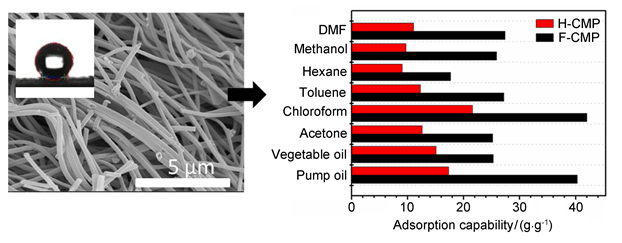| [1] Shannon, M. A.; Bohn, P. W.; Elimelech, M.; Georgiadis, J. G.; Marinas, B. J.; Mayes, A. M. Nature 2008, 452, 301.
[2] Doshi, B.; Sillanpaa, M.; Kalliola, S. Water Res. 2018, 135, 262.
[3] Gupta, S.; Tai, N. H. J. Mater. Chem. A 2016, 4, 1550.
[4] Lei, E.; Li, W.; Ma, C.; Liu, S. Mater. Chem. Phys. 2018, 214, 291.
[5] Mohan, D.; Singh, K. P.; Singh, V. K. J. Hazard Mater. 2008, 152, 1045.
[6] Sakthivel, T.; Reid, D. L.; Goldstein, I.; Hench, L.; Seal, S. Environ. Sci. Technol. 2013, 47, 5843.
[7] Likon, M.; Remskar, M.; Ducman, V.; Svegl, F. J. Environ. Manage. 2013, 114, 158.
[8] Zhang, T.; Kong, L.; Dai, Y.; Yue, X.; Rong, J.; Qiu, F.; Pan, J. Chem. Eng. J. 2017, 309, 7.
[9] Chin, S. F.; Binti, R. A. N.; Pang, S. C. Mater. Lett. 2014, 115, 241.
[10] Ong, C. C.; Sundera, M. S.; Mohamed, N. M.; Perumal, V.; Mohamed, S. M. S. ACS Omega. 2018, 3, 15907.
[11] Ji, C.; Zhang, K.; Li, L.; Chen, X.; Hu, J.; Yan, D.; Xiao, G.; He, X. J. Mater. Chem. A 2017, 5, 11263.
[12] Peng, D.; Jiang, W.; Li, F. F.; Zhang, L.; Liang, R. P.; Qiu, J. D. ACS Sustainable Chem. Eng. 2018, 6, 11685.
[13] Dawson, R.; Laybourn, A.; Clowes, R.; Khimyak, Y. Z.; Adams, D. J.; Cooper, A. I. Macromolecules 2009, 42, 8809.
[14] Dawson, R.; Cooper, A. I.; Adams, D. J. Prog. Polym. Sci. 2012, 37, 530.
[15] Yan, T. T.; Xing, G. L.; Ben, T. Acta Chim. Sinica 2018, 76, 366. (闫婷婷, 邢国龙, 贲腾, 化学学报, 2018, 76, 366.)
[16] Pang, C.; Luo, S. H.; Hao, Z. F.; Gao, J.; Huang, Z. H.; Yu, J. H.; Yu, S. M.; Wang, Z. Y. Chin. J. Org. Chem. 2018, 38, 2606. (庞楚明, 罗时荷, 郝志峰, 高健, 黄召昊, 余家海, 余思敏, 汪朝阳, 有机化学, 2018, 38, 2606.)
[17] Yu, S.; Xu, Y. J.; Jiang, J. X.; Ren, S. J. Acta Chim. Sinica 2015, 73, 629. (于森, 徐雍捷, 蒋加兴, 任世杰, 化学学报, 2015, 73, 629.)
[18] Xu, Y.; Jin, S.; Xu, H.; Nagai, A.; Jiang, D. Chem. Soc. Rev. 2013, 42, 8012.
[19] Jiang, J. X.; Su, F.; Trewin, A.; Wood, C. D.; Campbell, N. L.; Niu, H.; Dickinson, C.; Ganin, A. Y.; Rosseinsky, M. J.; Khimyak, Y. Z.; Cooper, A. I. Angew. Chem. Int. Ed. 2007, 46, 8574.
[20] Chen, Q.; Liu, D. P.; Luo, M.; Feng, L. J.; Zhao, Y. C.; Han, B. H. Small 2014, 10, 308.
[21] Wang, X.; Chen, B.; Dong, W.; Zhang, X.; Li, Z.; Xiang, Y.; Chen, H. Macromol. Rapid Commun. 2018, e1800494.
[22] Kong, S. N.; Malik, A. U.; Qian, X. F.; Shu, M. H.; Xiao, W. D. Chin. J. Org. Chem. 2018, 38, 656. (孔胜男, Abaid Ullah Malik, 钱雪峰, 舒谋海, 肖文德, 有机化学, 2018, 38, 656.)
[23] Kong, S. N.; Qian, X. F.; Shu, M. H.; Xiao, W. D. Chin. J. Org. Chem. 2018, 38, 2754. (孔胜男, 钱雪峰, 舒谋海, 肖文德, 有机化学, 2018, 38, 2754.)
[24] Xu, Y. J.; Wu, S. P.; Ren, S. J.; Ji, J.; Yue, Y.; Shen, J. J. RSC Adv. 2017, 7, 32496.
[25] He, Q.; Zhang, C.; Li, X.; Wang, X.; Mu, P.; Jiang, J. X. Acta Chim. Sinica 2018, 76, 202. (贺倩, 张崇, 李晓, 王雪, 牟攀, 蒋加兴, 化学学报, 2018, 76, 202.)
[26] Liao, Y.; Cheng, Z.; Zuo, W.; Thomas, A.; Faul, C. F. J. ACS Appl. Mater. Interfaces 2017, 9, 38390.
[27] Bildirir, H.; Osken, I.; Ozturk, T.; Thomas, A. Chemistry 2015, 21, 9306.
[28] Qiu, F.; Zhao, W.; Han, S.; Zhuang, X.; Lin, H.; Zhang, F. Polymers 2016, 8, 191.
[29] Yang, R. X.; Wang, T. T.; Deng, W. Q. Sci. Rep. 2015, 5, 10155.
[30] Lee, J. S. M.; Wu, T. H.; Alston, B. M.; Briggs, M. E.; Hasell, T.; Hu, C. C.; Cooper, A. I. J. Mater. Chem. A 2016, 4, 7665.
[31] Qin, L.; Xu, G. j.; Yao, C.; Xu, Y. Polym. Chem. 2016, 7, 4599.
[32] Cha, M. C.; Lim, Y.; Choi, T. J.; Chang, J. Y. Macromol. Chem. Phys. 2017, 218, 1700219.
[33] Shen, X.; He, J.; Wang, K.; Li, X.; Wang, X.; Yang, Z.; Wang, N.; Zhang, Y.; Huang, C. ChemSusChem 2019, 12, 1342.
[34] Zhao, X.; Wu, M.; Liu, Y.; Cao, S. Org. Lett. 2018, 20, 5564.
[35] Ju, Z.; Zhang, S.; Xing, Z.; Zhuang, Q.; Qiang, Y.; Qian, Y. ACS Appl. Mater. Interfaces 2016, 8, 20682.
[36] Wang, X.; Mu, P.; Zhang, C.; Chen, Y.; Zeng, J.; Wang, F.; Jiang, J. X. ACS Appl. Mater. Interfaces 2017, 9, 20779.
[37] Xu, L.; Xiao, G.; Chen, C.; Li, R.; Mai, Y.; Sun, G.; Yan, D. J. Mater. Chem. A 2015, 3, 7498.
[38] Wenk, H. H.; Sander, W. Eur. J. Org. Chem. 2002, 3927. |
